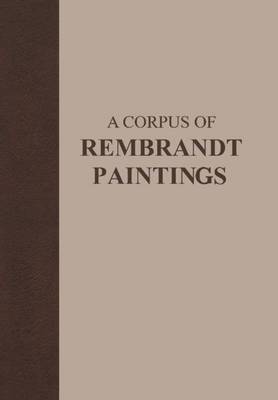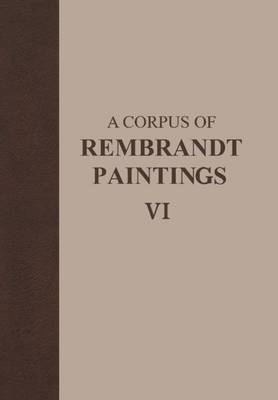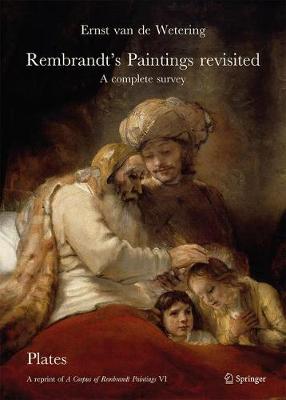Rembrandt Research Project Foundation
3 primary works
Book 1
A Corpus of Rembrandt Paintings
by J. Bruyn, J. Haak, S.H. Levie, P.J.J. van Thiel, and Ernst van de Wetering
Since the second half of the last century, art historians, realizing that the image of Rembrandt’s work had become blurred with time, have attempted to redefine the artist’s significance both as a source of inspiration to other artists and as a great artist in his own right. Carrying on the work started by previous generations, a group of leading Dutch art historians from the university and museum world joined forces in the late 1960s in order to study afresh the paintings usually ascribed to Rembrandt. The researchers came together in the Rembrandt Research Project (RRP). In the course of the completion of this project and the publication of the six volumes, the composition of the group of researchers changed, and at the same time, the group’s approach changed as a result of art-historical and methodological developments.
The changes and developments are reflected in the break in style between volumes III and IV. The first three volumes take a historical and chronological approach. They cover Rembrandt’s early years in Leiden (1629-1631), his first years in Amsterdam (1631-1634), and finally his later years of reputation (1635-1642). The fourth and fifth volume take a thematic approach.Dedicated to Rembrandt’s self-portraits, volume IV looks at the valuation of autograph paintings, at dress and meaning in his self-portraits, and at authenticity and function. Volume V is about the small-scale history and genre paintings, an area considered to be the most challenging assignments for an artist. The volume presents the systematic research into this hitherto little known area, revealing a rich, and often fresh understanding of Rembrandt’s own way of thinking about these basic aspects. Volume VI, the set’s last volume, revisits Rembrandt’s paintings and is both a revisionary critique of the first three volumes and an independent overview.
Each volume combines a number of introductory chapters with a full catalogue of all paintings for the given period or theme. In the catalogues, each painting is discussed and examined in a detailed way, comprising a descriptive, an interpretative and a documentary section.
Book 6
A revised survey of Rembrandt’s complete painted oeuvre.
The question of which 17th-century paintings in Rembrandt’s style were actually painted by Rembrandt himself had already become an issue during his lifetime. It is an issue that is still hotly disputed among art historians today.
The problem arose because Rembrandt had numerous pupils who learned the art of painting by imitating their master or by assisting him with his work as a portrait painter. He also left pieces unfinished, to be completed by others.
The question is how to determine which works were from Rembrandt’s own hand. Can we, for example, define the criteria of quality that would allow us to distinguish the master’s work from that of his followers? Do we yet have methods of investigation that would deliver objective evidence of authenticity? To what extent do research techniques used in the physical sciences help? Or are we, after all, still dependent on the subjective, expert eye of the connoisseur? The book provides answers to these questions.
Prof. Ernst van de Wetering, the author of our forthcoming book which deals with these questions, has been closely involved in all aspects of this research since 1968, the year the renowned Rembrandt Research Project (RRP) was founded. In particular, he played an important role in developing new criteria for authentication. Van de Wetering was also witness to the way the often overly zealous tendency to doubt the authenticity of Rembrandt’s paintings got out of hand. In this book he re-attributes to the master a substantial number of unjustly rejected Rembrandts. He also was closely involved in the (re)discovery of a considerable number of lost or completely unknown works by Rembrandt.
The verdicts of earlier specialists – including the majority of members of the original RRP (up to 1989) – were based on connoisseurship: the self-confidence in one’s ability to recognise a specific artist’s style and ‘hand’. Over the years, Van de Wetering has carried out seminal research into 17th-century studio practice and ideas about art current in Rembrandt’s time. In this book he demonstrates the fallibility of traditional connoisseurship, especially in the case of Rembrandt, who was par excellence a searching artist.
The methodological implications of this critical view are discussed in an introductory chapter which relates the history of the developments in this turbulent field of research. Van de Wetering’s account of his own involvement in it makes this book a lively and sometimes unexpectedly personal account.
The catalogue section presents a chronologically ordered survey of Rembrandt’s entire painted oeuvre of 336 paintings, richly illustrated and annotated. For all the paintings re-attributed in this book, extensive commentaries have been included that provide a multi-facetted new insight into Rembrandt’s world and the world of art-historical research.
Rembrandt’s Paintings Revisited is the concluding sixth volume of A Corpus of Rembrandt Paintings (Volumes I-V; 1982, 1986, 1989, 2005, 2010). It can also be read as a revisionary critique of the first three Volumes published by the old RRP team up till 1989 and of Gerson’s influential survey of Rembrandt’s painted oeuvre of 1968/69. At the same time, the book is designed as an independent overview that can be used on the basis that anyone seeking more detailed information will be referred to the five previous (digital versions of the) Volumes and the detailed catalogues published in the meantime by the various museums with collections of Rembrandt paintings.
This work of art history and art research should belong in the library of every serious art historical institute, university or museum.
Book 6
The question of which 17th-century paintings in Rembrandt’s style were actually painted by Rembrandt himself had already become an issue during his lifetime. It is an issue that is still hotly disputed among art historians today.
The problem arose because Rembrandt had numerous pupils who learned the art of painting by imitating their master or by assisting him with his work as a portrait painter. He also left pieces unfinished, to be completed by others.
The question is how to determine which works were from Rembrandt’s own hand. Can we, for example, define the criteria of quality that would allow us to distinguish the master’s work from that of his followers? Do we yet have methods of investigation that would deliver objective evidence of authenticity? To what extent do research techniques used in the physical sciences help? Or are we, after all, still dependent on the subjective, expert eye of the connoisseur? The present book provides answers to these questions.
Prof. Ernst van de Wetering, the author of our forthcoming book which deals with these questions, has been closely involved in all aspects of this research since 1968, the year the renowned Rembrandt Research Project (RRP) was founded. In particular, he played an important role in developing new criteria for authentication. Van de Wetering was also witness to the way the often overly zealous tendency to doubt the authenticity of Rembrandt’s paintings got out of hand. In this book he re-attributes to the master a substantial number of unjustly rejected Rembrandts. He also was closely involved in the (re)discovery of a considerable number of lost or completely unknown works by Rembrandt.
The verdicts of earlier specialists – including the majority of members of the original RRP (up to 1989) – were based on connoisseurship: the self-confidence in one’s ability to recognise a specific artist’s style and ‘hand’. Over the years, Van de Wetering has carried out seminal research into 17th-century studio practice and ideas about art current in Rembrandt’s time. In this book he demonstrates the fallibility of traditional connoisseurship, especially in the case of Rembrandt, who was par excellence a searching artist.
The methodological implications of this critical view are discussed in an introductory chapter which relates the history of the developments in this turbulent field of research. Van de Wetering’s account of his own involvement in it makes this book a lively and sometimes unexpectedly personal account.
The catalogue section presents a chronologically ordered survey of Rembrandt’s entire painted oeuvre of 336 paintings, richly illustrated and annotated. For all the paintings re-attributed in this book, extensive commentaries have been included that provide a multi-facetted new insight into Rembrandt’s world and the world of art-historical research.
Rembrandt’s Paintings Revisited is a reprint of the concluding sixth volume of A Corpus of Rembrandt Paintings (Volumes I-V; 1982, 1986, 1989, 2005, 2010). It can also be read as a revisionary critique of the first three Volumes published by the old RRP team up till 1989 and of Gerson’s influential survey of Rembrandt’s painted oeuvre of 1968/69. At the same time, the book is designed as an independent overview that can be used on the basis that anyone seeking more detailed information will be referred to the five previous (digital versions of the) Volumes and the detailed catalogues published in the meantime by the various museums with collections of Rembrandt paintings.
This work of art history and art research should belong in the library of every serious art historical institute, university or museum.


